[Qianjie barista examination] check Qianjie irregularly for exams.
Professional coffee knowledge exchange more coffee bean information please follow the coffee workshop (Wechat official account cafe_style)
[preface]
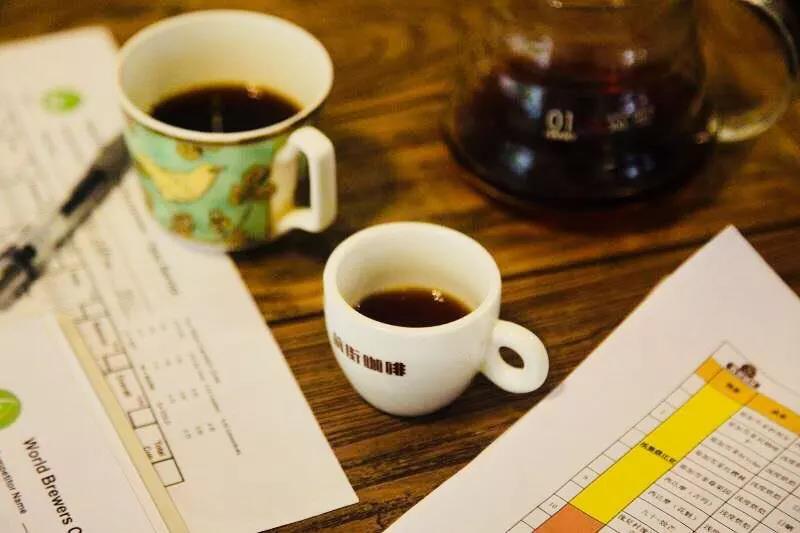
I believe some of my friends have found that there will be "spot checks" on our front street from time to time, so why do we have to take the exam? In addition to testing our familiarity with beans, it is more important to show you a good cup of coffee and enjoy the taste and story of a cup of coffee. How do you take the test? Of course, it is not simply to make a cup of coffee, what is the specific process? First of all, I'd like to introduce you to the score record table we use:
Scoring Table of the World Coffee Brewing Competition (WBrC)
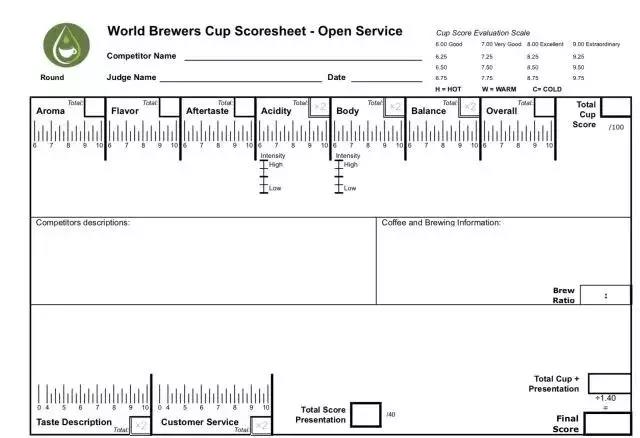
1, damp incense
Basically, the wet aroma of coffee corresponds to the place where the coffee is produced. In contrast, the intensity of the wet aroma is usually related to the freshness of the coffee, measured by the period between the roasting date and the use date of the coffee, and also affected by the packaging isolation of moisture and oxygen. Wet aroma refers to the aroma of coffee liquid. in general, the wet aroma of coffee is far less obvious than the dry aroma in the sense of smell. when using the sense of smell to identify the wet aroma, we usually take advantage of the high temperature of coffee and use the volatilization of coffee to identify the wet aroma.
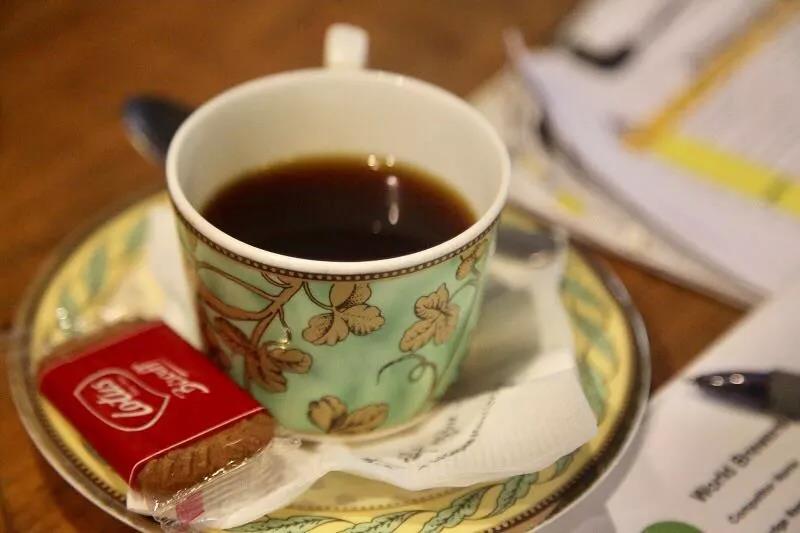
2, flavor
Flavor represents the main characteristics of coffee, is the "middle" sensory experience, including a variety of taste and smell, even in the nasal aroma and oral touch between the wet aroma and acidity of coffee between the first impression and the final finish. The flavor combines the perception of all taste buds with the impression of coffee by the sense of smell behind the nose. This score item must include the intensity, texture, and complexity of taste and wet aromas, and all taste buds can participate in this taste assessment through strong sipping. If you really don't know how to describe it, you can look at the flavor wheel for reference:
How to identify the flavor of individual beans? How to smell the incense bottle?
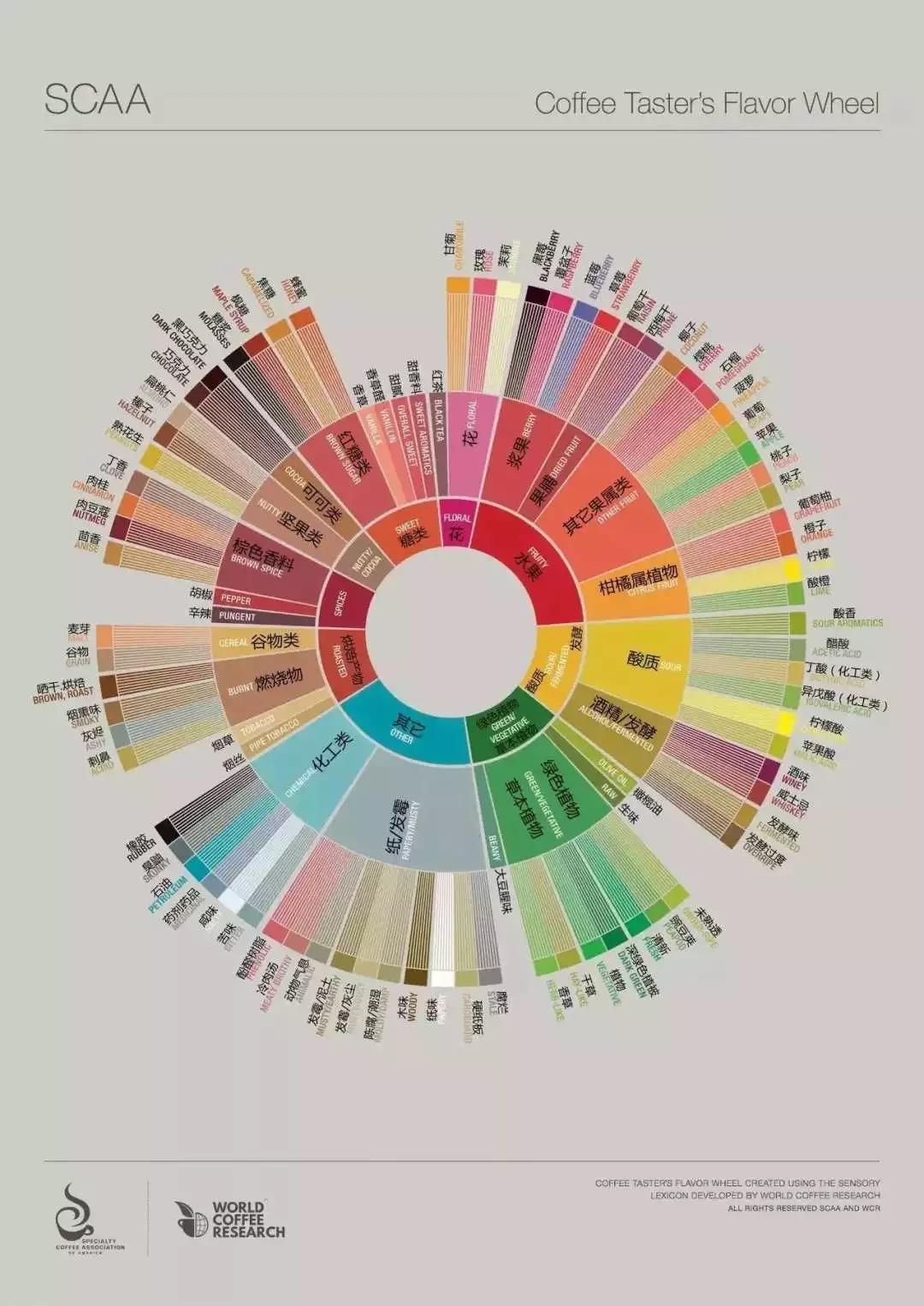
3, Yu Yun
The aftertaste is defined as the length of time that positive flavor traits (taste and aroma) remain at the back of the tongue after the coffee has been drunk or vomited. After sipping, all kinds of taste or aroma or touch still stay in the mouth, and the good flavor stays for a long time, such as sweetness, still clearly stays in the mouth or even scattered after sipping and spitting the coffee.
If the remaining rhyme is short or has negative characteristics, thus reducing the experience of the cup of coffee, you will get a lower score; if the remaining rhyme enhances the experience of the cup of coffee, you will get a high score. Then the score of this item will be high, on the contrary, if there is no aftertaste, or very short, the score will be low.
4, acid quality
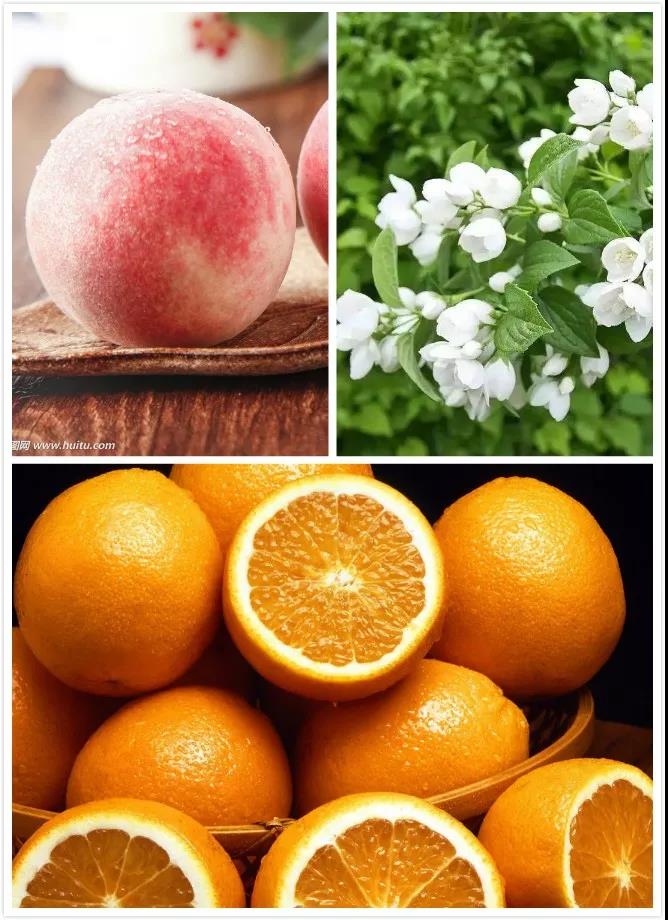
Sour quality when it has a positive flavor is often described as the "brightness" of coffee. A good sour quality is not like vinegar. Even if it is bright and lively, many kinds of acidity can be detected, such as citrus, berries or sweet lemons. There are also melons like cantaloupe sweet and sour or fresh ripe apples with crisp sour fruit. When it has a negative flavor, it will be described as "stinky acid", bad acid is like unripe fruit or acetic acid, some bad acid is like overripe fruit or rotten fruit, fermented acid or rotten fruit can be detected.
At best, acidity gives coffee sweetness, lively texture, and flavor traits like fresh fruit, which are usually felt and evaluated immediately when coffee is drunk. However, excessively strong or significant acidity may make people feel uncomfortable, and excessive acidity may not be appropriate for the flavor characteristics of the coffee.

The final score indicated on the horizontal scale must reflect the perceived acidity of the judges, which is the flavor profile expected based on the terroir characteristics of the coffee production site or other factors (roasting degree, brewing purpose, etc.).
During the exam, we will ask for coffee related information, including origin information, varieties and processing methods, to be linked and transmitted to the performance coffee, high or low acid strength, but if the acid quality is good, there will be a good score reflected in the score, but also reflected in the overall feeling.
5, mellow

How to understand the thickness of alcohol? sticky Italian concentration can be said to be the performance of body. In addition to the high alcohol thickness of sticky espresso, succulent taste can sometimes give a high alcohol thickness (imagine drinking soup, juice, good tea). Body is not some kind of iconic taste that we can taste, but a feeling, a sense of weight.
The quality of alcohol thickness is based on the touch of the drink in the mouth, especially between the tongue and the upper jaw. Coffee with "heavy" or "light" alcohol thickness may get a high score on texture because the liquid has a good tactile feel in the mouth. However, some pure "light" coffee may also have a pleasant feeling in the mouth. Coffee with heavier alcohol thickness or lighter alcohol thickness is likely to get a relatively high score on the texture of alcohol thickness, although the intensity of the two is quite different.
6, degree of balance
Refers to the balance of each evaluation of coffee, the balance integrates all the elements of the coffee, including flavor, aftertaste, acidity, and alcohol thickness to show complementary or contrastive feelings. If the coffee lacks a certain aroma or flavor, or if some characteristics are too strong, the score of balance will be lower. For example, although the acid is bright, it still turns sweet? The touch is sticky but not astringent? Whether the various flavors of coffee are harmonious, the score of this item will be high.
7, overall impression
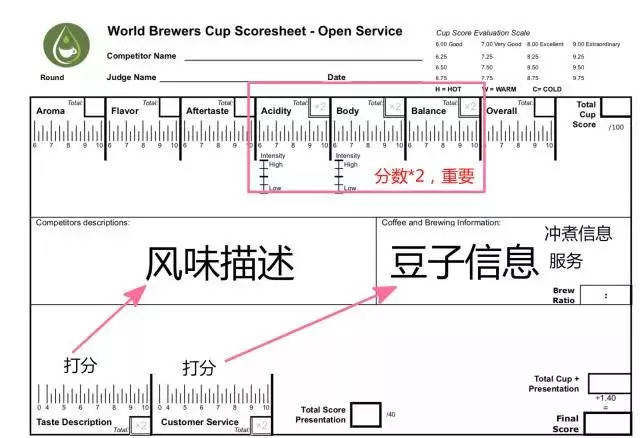
The "overall impression" rating reflects the judge's most comprehensive and complete perception of the brewed beverage. If a coffee drink performs well on many levels but is "not good enough," it will still get a low score. To get a high score in this category, you need to fully present the unique terroir characteristics of a coffee in terms of flavor and meet the expectations of its characteristics. The best example. If a particular trait is not properly highlighted in an individual rating item, the overall impression may be higher to reflect the performance of that trait, which is evaluated by the judges based on personal perception.
As the coffee cools, the judges rate each item at three different temperatures:
(1)"Hot" is defined as approximately 70°C
(2)"Warm" is defined as approximately 40°C
(3)"Cold" is defined as between 25°C and 30°C

Record the score of the drink with a scoring ruler, draw a line on the strength ruler and circle it to indicate the degree of quality. If there is a change in the degree of evaluation (if the texture of some characteristics increases or decreases after cooling), draw a line on the strength ruler to indicate the new range and an arrow to indicate the direction in which the score was last modified.
When the temperature of the drink cools to 25 °C, the score is stopped, and the score of the overall impression is determined by the review after taking into account all the sensory traits.
The judges should clearly mark the scores of "hot", "warm" and "cold" on the horizontal scale in the rating form, which can be represented by the letters H, W and C respectively, or circle and arrow to indicate how the quality changes over time.
The judges will record the sensory evaluation feelings in detail in the note fields on the score sheet. As a reference for scoring and to help contestants understand the evaluation. The judges must limit their content to describe their feelings about coffee drinks from the perspective of sensory evaluation or customers, and avoid critical brewing methods. (for example, a "sharp acid" or "sack smell" is an acceptable description. "it takes too long to cook" or "insufficient extraction" is not an appropriate comment. )
Scoring scale
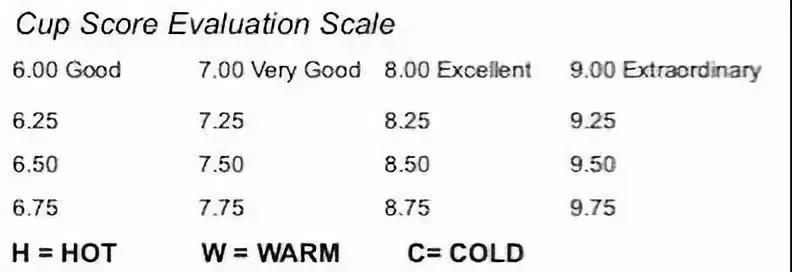
Limited to the following areas:
Judges must be graded on this scale: good, good, excellent, and excellent. Judges shall not give scores less than 6.00. The degree below "good" is calculated as 6.00 points.
Each scoring item is marked with a horizontal rating scale (from left to right) to evaluate the relative quality felt by the item, and the evaluation of the quality of the cup is based on the understanding of the quality in the evaluation experience.
Some projects also have a straight grading scale. The straight scoring scale (top to bottom) is used to indicate the intensity of the sensory part as a record and reference, and is not included in the score.
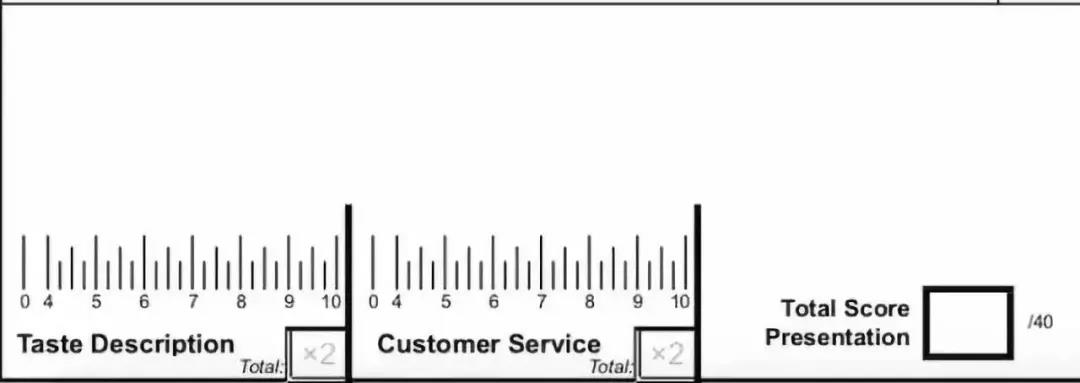
After the evaluation is completed, the score will be recorded in the totals column of each form. The scorer will calculate the total score accumulated for each project.
Having said so much, how to go to the actual examination process? How to introduce this bean? Let's take Alida tanning iron truck as an example to make an explanation:
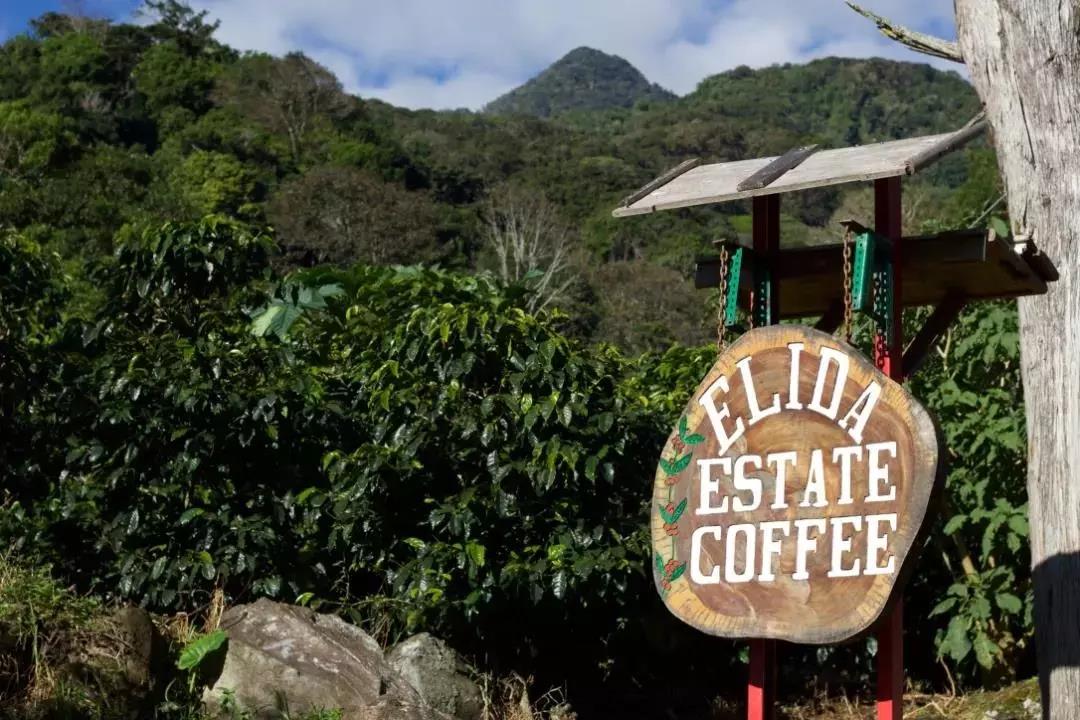
A stunning bean [Alida tanning iron truck] is made for you today. As the name implies, she comes from Alida Manor, which is located in the Pokuit producing area of Panama. Pokuit is a town of Chiriqui in Chiriki province, located near the border between Panama and Costa Rica, near the famous Baru Baru volcano. From east to west, the environment allows cold air to converge at more than 1670 meters to 1850 meters through the central mountains. As a result, a variety of microclimates have been created in the Pokuit region, making its temperature and rainfall very suitable for plant growth, so the coffee trees grown here are in good condition.
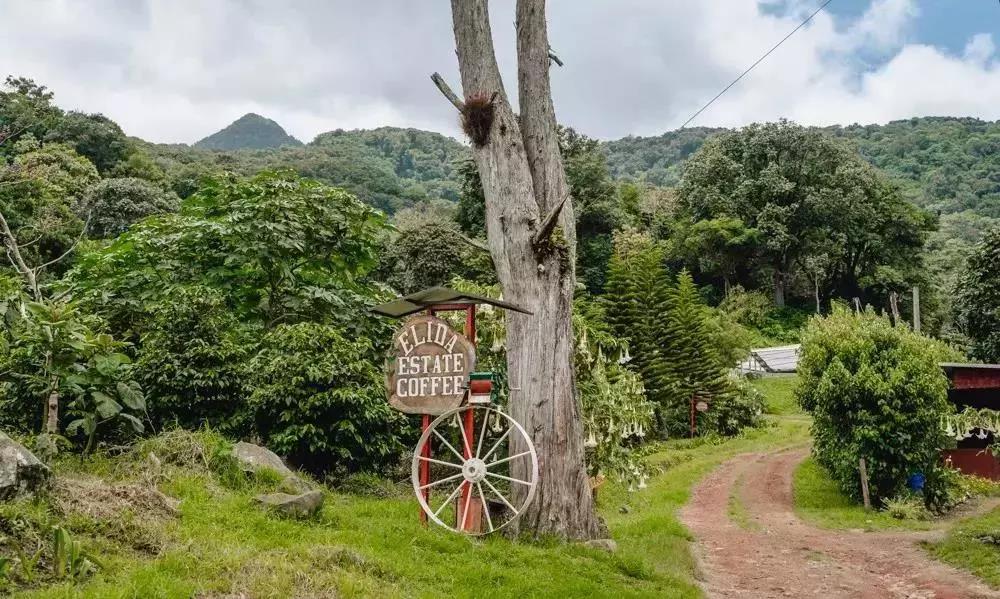
Only 30 hectares of the estate is used for planting coffee trees, and the rest are primeval forests. At such a high altitude, the low temperature delayed the ripening of the coffee berries, about a month later than the normal ripening period, and the fertile volcanic soil provided sufficient nutrients for the coffee, coupled with the good microclimate brought by the Baru volcano. Alida Manor has been able to achieve good results in cup test competitions.
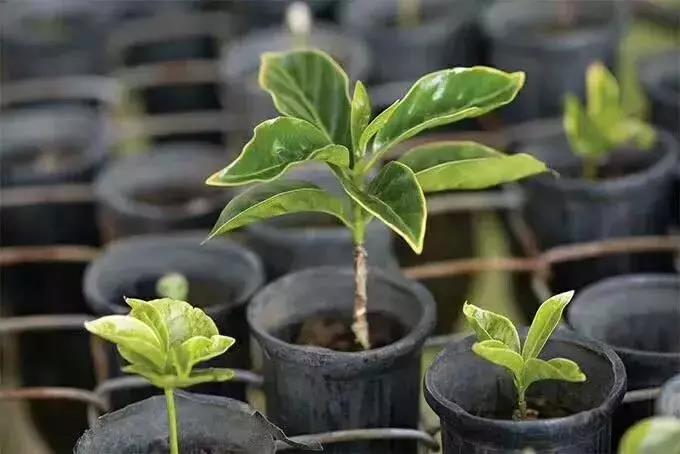
There are three main varieties of planting in Alida Manor, namely, Kaduai, Itsuka and Rosa. The processing plant of the manor is halfway up the hillside. After the coffee is picked, it can be transported to the factory for processing as soon as possible to ensure that the quality of the coffee fruit will not be affected. Now the estate is inherited by the descendants of the Lamastus family. And this bean variety is the iron pickup, one of the oldest varieties of Arabica coffee she has discovered today. The Arabica species originated in Ethiopia, where it still grows naturally today in the highlands of the pristine rainforest.
The variety of iron pickup has slender beans, tall trees, oval fruit and slightly inclined branches. The four iron pickups are slender and unfolding, with a tilt angle of 50 mi 70 degrees. The coffee yield of each tree is very low, but the cup test score is very high.
Mr. Wilford, the owner of the manor, has also made considerable efforts in harvesting and processing. In order to reach the highest standard, only the most ripe coffee fruits are allowed to be picked by hand. The maturity of the fruit is high, and the sugar content of pectin is naturally high, which is also the basis for producing high-quality flavor. The use of exquisite sun, the placement of elevated beds and shade sheds, irregular turning, drying after "purification", but also more stringent than the same industry, need to go through more than 5 months of low-temperature Resting to green, so that the flavor of coffee can have a more balanced and full development.
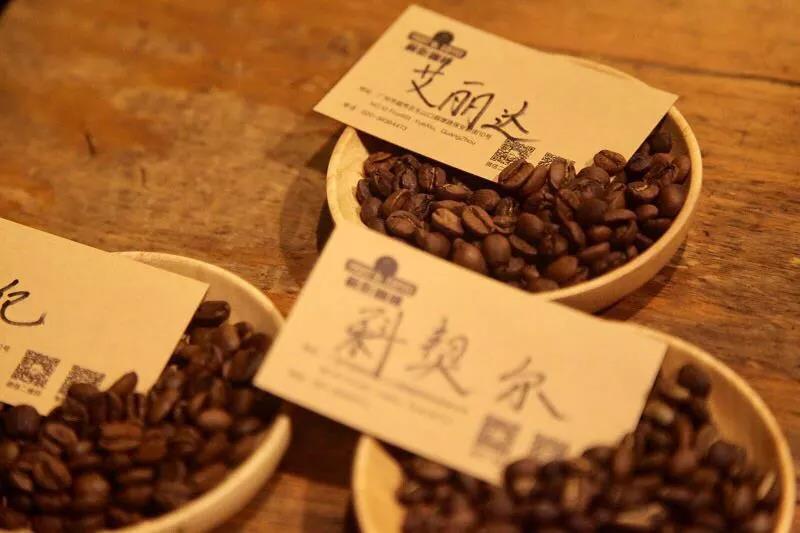
This bean is a medium-shallow baking degree, retaining her caramel and light floral fragrance. Today, I use 90 degrees, BG 5R (American powder sieve passes 60%), gouache is boiled in a three-stage style compared to 1R15, V60, V60 filter cup in order to extract the sense of hierarchy in a short time, first steam with 25g water for 30 seconds, the first stage of water injection to 120g, small water slowly circle from the inside to the outside, the outer ring is slightly faster. When the liquid level drops slowly by 1 stroke 3-1 / 2, the second stage water injection begins, the water injection reaches 225g, the flow and winding velocity increase a little, and the extraction stops at 2:05 seconds.
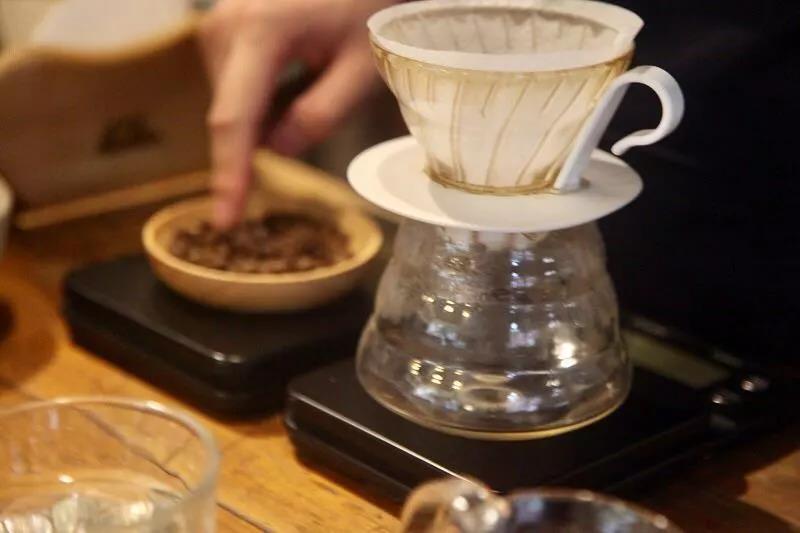
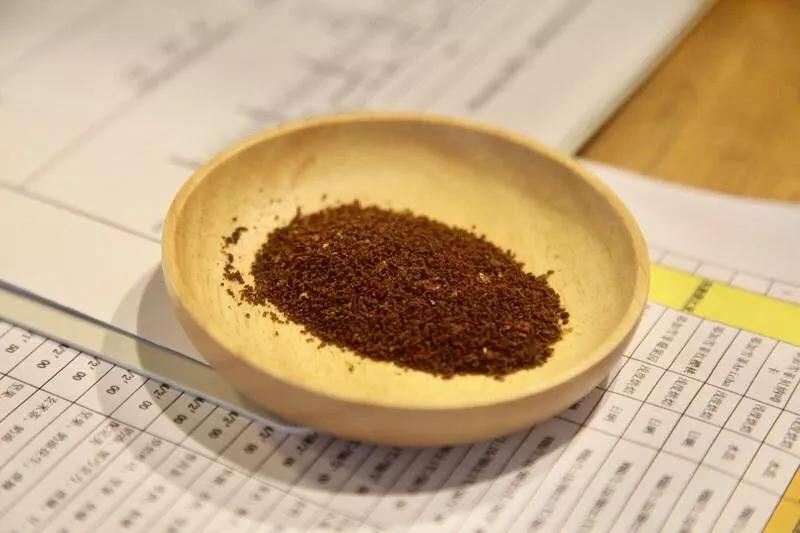
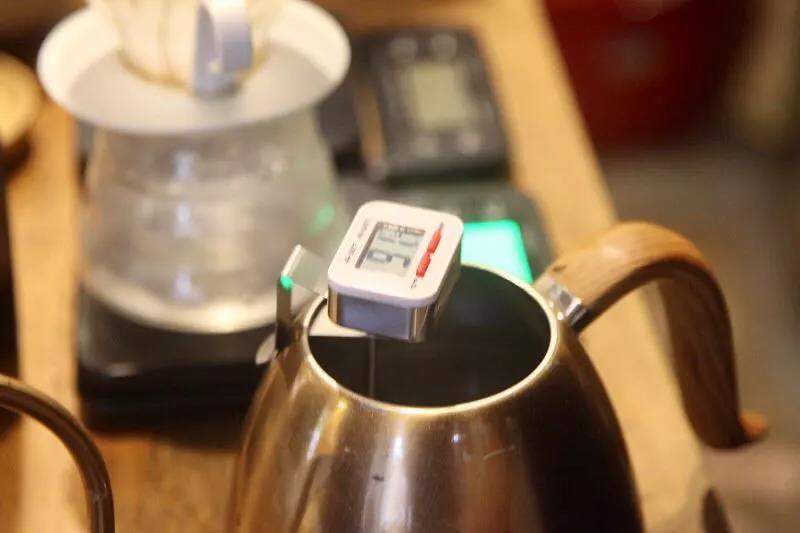
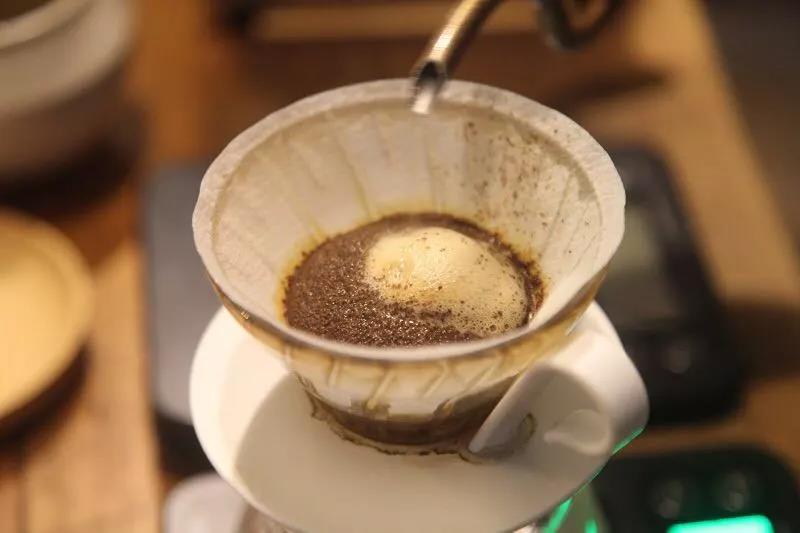
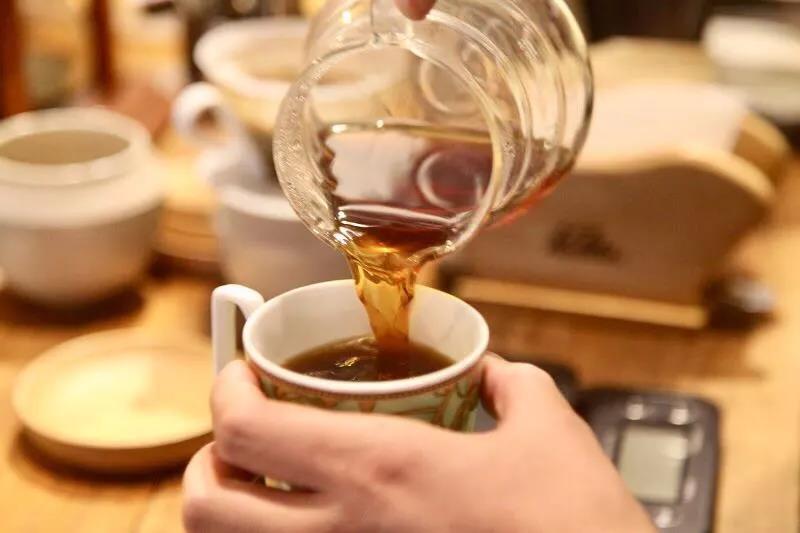
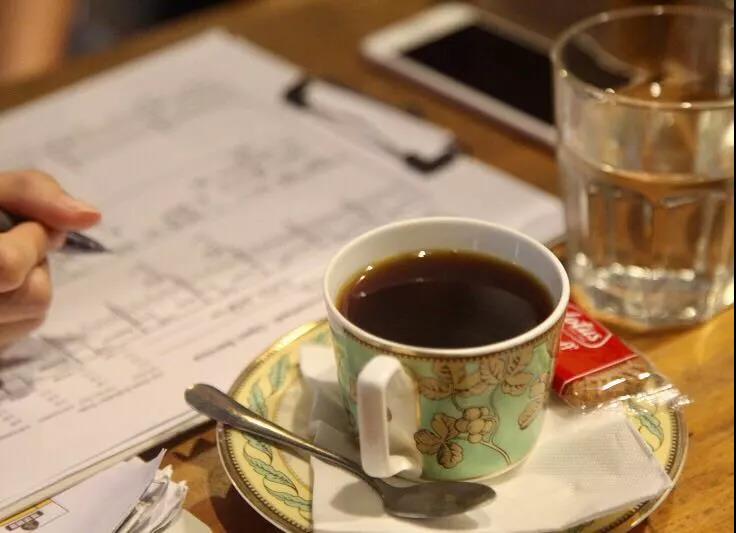
This cup [Alida Sun] has the sour taste of jasmine and orange in the front, melon, sugar and jackfruit in the middle, grapefruit and green tea in the back, high cleanliness and smooth entrance. I hope you like it!
This is the process of our daily exam, from the planting information of a bean to cup testing, brewing and tasting, we baristas also work hard to show you a better taste.
[preface]
I believe some of my friends have found that there will be "spot checks" on our front street from time to time, so why do we have to take the exam? In addition to testing our familiarity with beans, it is more important to show you a good cup of coffee and enjoy the taste and story of a cup of coffee. How do you take the test? Of course, it is not simply to make a cup of coffee, what is the specific process? First of all, I'd like to introduce you to the score record table we use:
Scoring Table of the World Coffee Brewing Competition (WBrC)
1, damp incense
Basically, the wet aroma of coffee corresponds to the place where the coffee is produced. In contrast, the intensity of the wet aroma is usually related to the freshness of the coffee, measured by the period between the roasting date and the use date of the coffee, and also affected by the packaging isolation of moisture and oxygen. Wet aroma refers to the aroma of coffee liquid. in general, the wet aroma of coffee is far less obvious than the dry aroma in the sense of smell. when using the sense of smell to identify the wet aroma, we usually take advantage of the high temperature of coffee and use the volatilization of coffee to identify the wet aroma.
2, flavor
Flavor represents the main characteristics of coffee, is the "middle" sensory experience, including a variety of taste and smell, even in the nasal aroma and oral touch between the wet aroma and acidity of coffee between the first impression and the final finish. The flavor combines the perception of all taste buds with the impression of coffee by the sense of smell behind the nose. This score item must include the intensity, texture, and complexity of taste and wet aromas, and all taste buds can participate in this taste assessment through strong sipping. If you really don't know how to describe it, you can look at the flavor wheel for reference:
How to identify the flavor of individual beans? How to smell the incense bottle?
3, Yu Yun
The aftertaste is defined as the length of time that positive flavor traits (taste and aroma) remain at the back of the tongue after the coffee has been drunk or vomited. After sipping, all kinds of taste or aroma or touch still stay in the mouth, and the good flavor stays for a long time, such as sweetness, still clearly stays in the mouth or even scattered after sipping and spitting the coffee.
If the remaining rhyme is short or has negative characteristics, thus reducing the experience of the cup of coffee, you will get a lower score; if the remaining rhyme enhances the experience of the cup of coffee, you will get a high score. Then the score of this item will be high, on the contrary, if there is no aftertaste, or very short, the score will be low.
4, acid quality
Acidity is often described as the "brightness" of coffee when it has a positive flavor, good acidity is not like vinegar, even if bright and lively, it can be detected as a variety of acids such as citrus, berry or sweet lemon, there are also sweet acids such as honeydew melon or crispy fruit acid of young ripe apples; and when it has a negative flavor, it is described as "smelly acid", bad acid is like unripe fruit or acetic acid, and some bad acids are like overripe fruit or rotten fruit, when fermentation acid or rotten fruit can be detected.
At its best, the acidity gives coffee sweetness, a lively texture, and flavor characteristics like fresh fruit, which are often immediately felt and measured when the coffee is drunk. However, excessively strong or pronounced acidity may be unpleasant, and too much acidity may not be appropriate for the flavor characteristics of the coffee.
The final score marked on the horizontal scale must reflect the acid quality felt by the judges, which is based on the local characteristics of the coffee producing place or the flavor characteristics expected by other factors (roasting degree, brewing purpose, etc.).
During the exam, we will ask for coffee-related information, including origin information, variety and treatment, to be linked and transmitted to the exhibition coffee, the acid strength is high or low, but if the acid quality is good, there will be good results reflected in the score, will also be reflected in the overall feeling.
5, alcohol thickness
How to understand the thickness of alcohol? sticky Italian concentration can be said to be the performance of body. In addition to the high alcohol thickness of sticky espresso, succulent taste can sometimes give a high alcohol thickness (imagine drinking soup, juice, good tea). Body is not some kind of iconic taste that we can taste, but a feeling, a sense of weight.
The quality of alcohol thickness is based on the touch of the drink in the mouth, especially between the tongue and the upper jaw. Coffee with "heavy" or "light" alcohol thickness may get a high score on texture because the liquid has a good tactile feel in the mouth. However, some pure "light" coffee may also have a pleasant feeling in the mouth. Coffee with heavier alcohol thickness or lighter alcohol thickness is likely to get a relatively high score on the texture of alcohol thickness, although the intensity of the two is quite different.
6, degree of balance
Refers to the balance of each evaluation of coffee, the balance integrates all the elements of the coffee, including flavor, aftertaste, acidity, and alcohol thickness to show complementary or contrastive feelings. If the coffee lacks a certain aroma or flavor, or if some characteristics are too strong, the score of balance will be lower. For example, although the acid is bright, it still turns sweet? The touch is sticky but not astringent? Whether the various flavors of coffee are harmonious, the score of this item will be high.
7, overall impression
The score of "overall impression" is used to reflect the judge's most comprehensive and complete feeling about the cooking drink. If a coffee drink performs well on many levels, but it is "not in place", it will still get a lower score. To get a high score in this item, it is necessary to fully present the unique local characteristics of a coffee in flavor, and in line with the expectations of its characteristics. The best example. If the quality of a preference cannot be properly highlighted in an individual score, the score on the overall impression may be higher, reflecting the performance of the trait, which allows the judge to evaluate on the basis of personal perception.
As the coffee cools, the judges will rate each item at three different temperatures:
(1) "heat" is defined as about 70 °C
(2) "temperature" is defined as about 40 °C
(3) "cold" is defined as between 25 °C and 30 °C.
Record the score of the drink with a scoring ruler, draw a line on the strength ruler and circle it to indicate the degree of quality. If there is a change in the degree of evaluation (if the texture of some characteristics increases or decreases after cooling), draw a line on the strength ruler to indicate the new range and an arrow to indicate the direction in which the score was last modified.
When the temperature of the drink cools to 25 °C, the score is stopped, and the score of the overall impression is determined by the review after taking into account all the sensory traits.
The judges should clearly mark the scores of "hot", "warm" and "cold" on the horizontal scale in the rating form, which can be represented by the letters H, W and C respectively, or circle and arrow to indicate how the quality changes over time.
The judges will record the sensory evaluation feelings in detail in the note fields on the score sheet. As a reference for scoring and to help contestants understand the evaluation. The judges must limit their content to describe their feelings about coffee drinks from the perspective of sensory evaluation or customers, and avoid critical brewing methods. (for example, a "sharp acid" or "sack smell" is an acceptable description. "it takes too long to cook" or "insufficient extraction" is not an appropriate comment. )
Scoring scale
Limited to the following areas:
Judges must be graded on this scale: good, good, excellent, and excellent. Judges shall not give scores less than 6.00. The degree below "good" is calculated as 6.00 points.
Each scoring item is marked with a horizontal rating scale (from left to right) to evaluate the relative quality felt by the item, and the evaluation of the quality of the cup is based on the understanding of the quality in the evaluation experience.
Some projects also have a straight grading scale. The straight scoring scale (top to bottom) is used to indicate the intensity of the sensory part as a record and reference, and is not included in the score.
After the evaluation is completed, the score will be recorded in the totals column of each form. The scorer will calculate the total score accumulated for each project.
Having said so much, how to go to the actual examination process? How to introduce this bean? Let's take Alida tanning iron truck as an example to make an explanation:
A stunning bean [Alida tanning iron truck] is made for you today. As the name implies, she comes from Alida Manor, which is located in the Pokuit producing area of Panama. Pokuit is a town of Chiriqui in Chiriki province, located near the border between Panama and Costa Rica, near the famous Baru Baru volcano. From east to west, the environment allows cold air to converge at more than 1670 meters to 1850 meters through the central mountains. As a result, a variety of microclimates have been created in the Pokuit region, making its temperature and rainfall very suitable for plant growth, so the coffee trees grown here are in good condition.
Only 30 hectares of the estate is used for planting coffee trees, and the rest are primeval forests. At such a high altitude, the low temperature delayed the ripening of the coffee berries, about a month later than the normal ripening period, and the fertile volcanic soil provided sufficient nutrients for the coffee, coupled with the good microclimate brought by the Baru volcano. Alida Manor has been able to achieve good results in cup test competitions.
There are three main varieties of planting in Alida Manor, namely, Kaduai, Itsuka and Rosa. The processing plant of the manor is halfway up the hillside. After the coffee is picked, it can be transported to the factory for processing as soon as possible to ensure that the quality of the coffee fruit will not be affected. Now the estate is inherited by the descendants of the Lamastus family. And this bean variety is the iron pickup, one of the oldest varieties of Arabica coffee she has discovered today. The Arabica species originated in Ethiopia, where it still grows naturally today in the highlands of the pristine rainforest.
Iron pickup this variety, beans slender, tall tree, fruit oval, branches slightly inclined. Iron pickup four slender, into a spread, inclined angle of 50-70 degrees, coffee production per tree is very low, but the cup test score is very high.
Wilford, the owner of the estate, has also made considerable efforts in harvesting and processing. In order to achieve the highest standards, only the most ripe coffee fruits are allowed to be picked by hand. The high maturity of the fruit and the naturally high sugar content of pectin are also the basis for producing high quality flavor. The use of refined sun, placed elevated bed and shade shed, irregular turning, drying after "purification", but also more rigorous than the same industry, after more than 5 months of low temperature Resting to green, so that coffee flavor has a more balanced, full development.
This bean is a medium-shallow baking degree, retaining her caramel and light floral fragrance. Today, I use 90 degrees, BG 5R (American powder sieve passes 60%), gouache is boiled in a three-stage style compared to 1R15, V60, V60 filter cup in order to extract the sense of hierarchy in a short time, first steam with 25g water for 30 seconds, the first stage of water injection to 120g, small water slowly circle from the inside to the outside, the outer ring is slightly faster. When the liquid level drops slowly by 1 stroke 3-1 / 2, the second stage water injection begins, the water injection reaches 225g, the flow and winding velocity increase a little, and the extraction stops at 2:05 seconds.
This cup [Alida Sun] has the sour taste of jasmine and orange in the front, melon, sugar and jackfruit in the middle, grapefruit and green tea in the back, high cleanliness and smooth entrance. I hope you like it!
This is the process of our daily exam, from the planting information of a bean to cup testing, brewing and tasting, we baristas also work hard to show you a better taste.
Important Notice :
前街咖啡 FrontStreet Coffee has moved to new addredd:
FrontStreet Coffee Address: 315,Donghua East Road,GuangZhou
Tel:020 38364473
- Prev
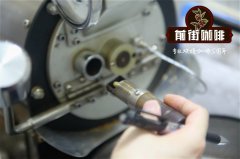
How to bake sun-cured coffee _ changes of sun-cured coffee beans during baking _ recommended
Professional coffee knowledge exchange more coffee bean information please follow the coffee workshop (Wechat official account cafe_style) roasted sun-cured coffee beans * 120 ℃ slightly open the throttle (slightly smaller than water-washed beans), because the sun beans tend to be woody dry, silver skin is not easy to peel, steaming coffee beans allow moisture to increase the maturity of the beans themselves and reduce dryness, keep the beans more moisture at 150 ℃, easy to steam the beans
- Next
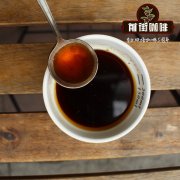
How should Turkish coffee be made? What is Turkish coffee? How to use the coffee pot in Turkey
Professional coffee knowledge exchange more coffee bean information Please follow the coffee workshop (Wechat official account cafe_style) mention coffee, the first thing that comes to mind is either Italy or the United States, but this addictive black drink was first widely circulated in the Arab world. If it were not for the bag that Turkey left behind during its retreat from the siege of Vienna in the 16th century
Related
- What is the meaning of lactic acid fermentation with coffee bean treatment?
- How to judge the state of foam by sound?
- How does the latte pull out the unicorn pattern? Come to get for a little trick to improve the flower pull!
- Will flower pulling affect the taste of the latte?
- Do you know the history of coffee?
- The difference between honey treatment and sun washing what is raisin honey treatment?
- What kind of milk can a novice use to make coffee foam to keep the foam longer? The correct method and skills of milking tutorial sharing
- Why do washed coffee beans taste sour? Flavor characteristics of washed Coffee
- Introduction to the skill of how to practice the size and height of water injection around the circle of hand-brewed coffee
- How do beginners practice coffee flower drawing from scratch?

